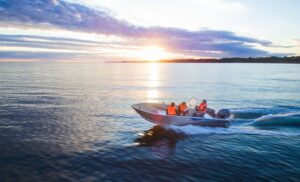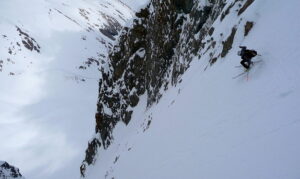In the last issue, we looked at why normal people or almost everybody, makes decisions that can be compromised or negatively influenced by rushing, frustration, fatigue and complacency; or, more likely, a combination of these states. In many cases, where the person or worker is making an exception: like not going to get the face shield because it’s really close to quitting time, the tradesperson does not want it to go into overtime, and it’s “just a small job” …
In many of these cases, the “exception” that they are making will be with something that isn’t necessary but rather with something that will make the consequences “less severe” if someone did make an error or something else happens unexpectedly. So, regardless of how much of a rush you’re in, you can’t start the car without the keys, but you can drive the car without putting the seatbelt on. You wouldn’t likely get into a canoe or small boat without paddles, but you could forget or decide not to bring lifejackets.
Here’s where it gets “interesting” though: you can leave the dock without paddles—if—you have a motor on the boat. And, you can leave the dock and breakwater area with a small amount of fuel. However, when you run out of gas, now you’re in the “ocean” (sometimes referred to as an unpleasant creek) without a paddle.

If you recall one of the examples or stories from the last unit: to take a guard off a cutting wheel requires a bit of thought and it’s not effortless; maybe not as effortful and walking 15 minutes there—only to find the tool crib has already closed—then walking 15 minutes back. And did I mention it was hot, like 40 degrees Celsius and oppressively humid (the story came from a workplace just outside of New Orleans). If, during any of that time, the man thought about why he was doing something differently: and he had to at least ask himself if this (what I’m doing right now) is mostly because of rushing, frustration, fatigue and complacency? And then he asked one more question: what’s the worst thing that could happen? Chances are, it wouldn’t have happened… Nothing is guaranteed, but if we could all extend the self-triggering technique—come back to the moment—and ask ourselves these two simple questions, many of these “exceptions” that lead to serious injuries and fatalities could have been prevented.
Now, on the other side, someone who “normally doesn’t” use a device, procedure or protocol to “further” reduce the risk, it’s usually nothing more than a natural resistance to change or resistance to changing a habit (despite what they might say, which might be very eloquently worded or emotionally charged). That’s why getting them to reflect on close calls or near-misses and how they could’ve been worse can be so effective here. But alas, the problem with critical decisions doesn’t stop with complacency causing normal or habitual at-risk behaviour or someone making an at-risk decision because of rushing, frustration or fatigue.
RISK THAT DEPENDS ON ERROR
The next concept is a big paradigm shift: especially when it actually happens to you. It’s one thing to read something and understand it. It’s quite another to discover it—at least for yourself—in the moment. The year was 1994. I was skiing in France at Val Isère, which is connected to Tignes by ski lifts and hills. Tignes is 23 km down the road. The resort is huge—probably the biggest or one of the biggest in the world. My ski companions were all engineers, friends of Ian, who I met skiing in Canada. They were all on a recreational ski club in university. They had maps. They had compasses. They planned every night for where we would ski. We had done this for eight straight days. Then there was a storm.
So, while we wait for the snow to fall (there was lots), let me go back to the original premise which this change in perspective came from. People don’t like risk they can’t influence. Many people are afraid to fly. They get scared, upset, fidgety, clamp the armrest with a death grip, or your arm if they don’t look… and yet, they weren’t afraid to drive to the airport or get in a taxi when they get to Mumbai. You tell them the statistics, but they are of little comfort. It seems everyone would prefer “control” over no control when it comes to life or limb type things.
In my case, I had blown my knee out (severely damaged ACL—anterior cruciate ligament) playing college basketball. Although I kept playing until the end of the season and into the playoffs, I really didn’t play much after college because you have to look up at the rim to get a rebound. If you come down on someone’s foot, you can roll your ankle or stress your knee—which, in my case, I knew was hanging by a thread (literally—a thread of ligament tissue). So, I quit playing basketball because it was too dangerous. I couldn’t afford to hurt my knee and be out of work because at the time (model/actor in Hollywood), my finances were also hanging by a thread. But I didn’t quit because I was worried about my skills. It was because of risk I couldn’t influence. And as mentioned, I wasn’t alone. Almost everybody is afraid—or shies away—from risk they can’t control.
Skiing, on the other hand is mostly risk that depends on error. Some falls are very simple: one or two states leading to one or more critical errors: one of which will be a loss of balance, traction or grip. But there are other kinds of errors, especially at a really big ski resort where you can ski wherever you want, once you get off-piste or off the main trails.

Well, the clouds finally lifted. There was almost a meter of new snow—powder—all over the mountains. The engineers had a plan. Things were going well. We were skiing fresh powder all morning long. But in the afternoon, it was harder to find places that were still untouched or did not have lots of ski tracks. However, they had maps. They had compasses. And we were still skiing fresh powder for two hours in the afternoon. For the next run, they told me that we were heading down a steep couloir, which is a narrow band of snow with rocks on each side. Elaine was out in front—she’s an amazing skier. Ian was second, I was third. Skis out far to the side, carving huge powder turns, snow flying in beautiful crescent arcs. Then suddenly, Elaine stopped. Then Ian stopped, and begrudgingly, I stopped.
“Why did you stop?” I asked, with frustration clearly discernible in my voice.
“Larry, we have to go back. And if you fall, you will die.” Ian had this way of “sugar-coating” everything.
What had happened is that we had gone down the wrong couloir. This one just ended at a cliff.
We had to side-step back up. It was about 40 degrees so each step up was effortful. If I fell, I might take Ian and Elaine with me. I started to freeze. So, scared I could barely move. But there wasn’t room for them to get around me. I had to start climbing or side-stepping up the hill. I forced one leg to move, then the other, then the upper leg again. Slowly, I was moving up the hill, Ian and Elaine following. Every move thought about. One step after another…
When we had climbed up a few hundred meters, I could see the top. We weren’t really safe yet, but I could see safety, and I distinctly remember saying to myself, “It’s a good thing I quit playing basketball because—let’s face it—it’s far too dangerous!” And that’s when I realized that risk that depends on error or not making any mistakes: grows over time. Risk you can’t influence stays pretty much the same. But risk that depends on not making any mistakes—those calculations are usually based on the assumption that you’ll be paying attention. But as we’ve discussed, over time (skiing for years and years), it is only natural for your mind to wander, or to not think everything through.
I assumed the people I was skiing with knew where we were going. I didn’t double-check, they didn’t double-check. But in a rush: to ski one more untracked run, combined with a lot of complacency: no problems so far that day or for the whole trip, we nearly made a fatal error. Good thing we weren’t playing basketball…
DELIBERATELY INCREASING MIND NOT ON TASK
However, or perhaps “unfortunately” would be a better word, there’s another aspect of deliberate risk and error that is also worth discussing: when people do things that they know will take their mind off task and that will increase the risk that they will make both of the first two critical errors at the same time. In other words, they are deliberately increasing the risk of a “Defenceless Moment” even though they may not really be aware of how much they are increasing the risk or how much risk there is for a serious injury or incident when their eyes and mind are both not on task at the same time. Probably the most common example of this is texting or reading something on your phone when you’re moving or when things—like cars and fork trucks—are moving around you. But there are many other forms of distraction that can take our eyes off the road or the walkway or stairway.

Habits can also play a part, especially if you are now so used to walking and texting or driving and texting that you don’t even think about it anymore. However, many people, try not to text and drive or not to even talk on the phone when driving. But, as we ‘ve discussed, most people also make exceptions if there’s enough rushing, frustration, fatigue and complacency involved. So, if they are making an exception to their own rule, then they probably will think about it when they decide to look at their phone when they’re driving or moving. However, they know they can look away for a second as long as they bring their eyes right back to the road. So, in most cases, there isn’t a problem, which is why they/we are willing to look away in the first place. We might even time it for when there aren’t any curves and the road is fairly straight for a while. We know that as long as we have our mind on task and on the risk at the moment, we can take our eyes off the road for a second without causing a big problem. But as we do this more often, we get a little more comfortable. Pretty soon this isn’t a new activity, it’s a familiar one.
THE EXTRA SECOND
Still, everything is OK, until that “extra second”. Something you looked at, whether it’s a text or a street sign or a sign that said, “Closed at 8:00pm Sunday” … Something caught your eye—literally—for that extra second, which you weren’t expecting. So, although you, me or another person may have been doing something deliberately that could be distracting, like driving and looking at the phone, we didn’t think we would actually get distracted for that extra second. And that extra second is always unexpected. It can also cause big problems especially if you’re driving 100 km/h or 60mph because you’re traveling 27.7 metres a second or 88 feet per second.
Almost everybody has experienced being distracted by that extra second. Some just had close calls, some had minor rear-end collisions or fender benders and others had worse (hit a pedestrian or someone on a bicycle). They knew it was a risk. What they didn’t know was the risk of the “extra second”. What’s also interesting is that most of them said they had experienced close calls before from the extra second but because nothing happened—it was just a close call—they didn’t really think about it. The second critical error reduction technique is really useful here, that’s where this paradigm shift comes from: you can do risky things—but only for a very short time. Once the fear or skill does not pre-occupy you anymore, you can’t really stop the risk of the “extra second” very reliably or with enough reliability. And unless you think about the extra second—so it doesn’t happen—you could very easily move into the line of fire or lose your balance, traction or grip, which will increase the risk of injury or incident.
There are two paradigm shifts or changes in perspectives brought forth in this article, and they are the two ways people can deliberately be increasing the risk of a situation—without knowing how much more they could actually be increasing the risk:
1. Not realizing that the “risk that depends on error” or not making any mistakes, will likely grow over time to exceed the risk for things you are not comfortable with—like risk you can’t influence (basketball vs. skiing).
2. In situations where people were willing to do things that they know could be distracting, they didn’t contemplate the risk of the “extra second” that could greatly increase the risk—like driving at highway speed and deliberately taking your eyes off the road..


SHARE THIS ARTICLE!